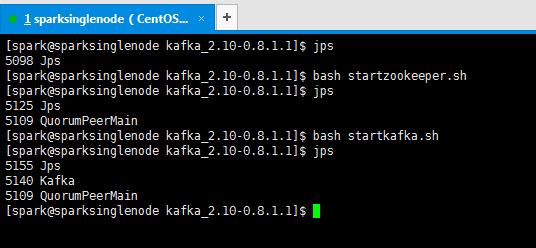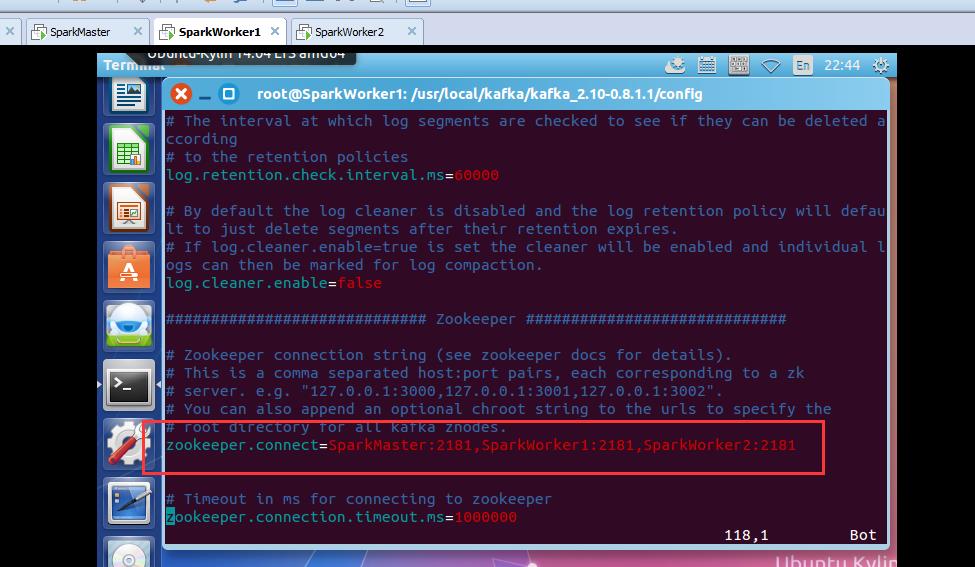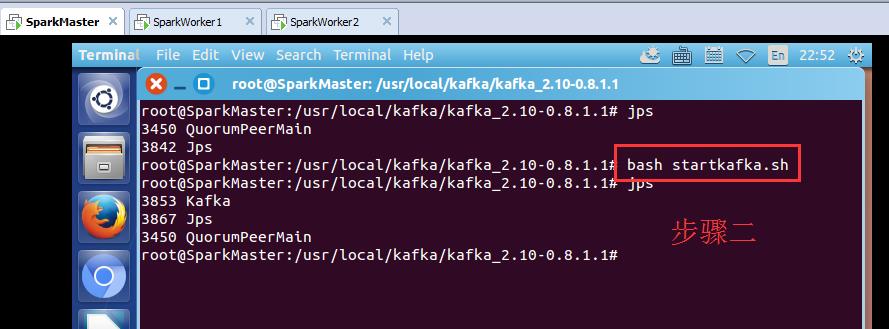kafka_2.10-0.8.1.1.tgz的1或3节点集群的下载安装和配置(图文详细教程)绝对干货
Posted 大数据和人工智能躺过的坑
tags:
篇首语:本文由小常识网(cha138.com)小编为大家整理,主要介绍了kafka_2.10-0.8.1.1.tgz的1或3节点集群的下载安装和配置(图文详细教程)绝对干货相关的知识,希望对你有一定的参考价值。
运行kafka ,需要依赖 zookeeper,你可以使用已有的 zookeeper 集群或者利用 kafka自带的zookeeper。
单机模式,用的是kafka自带的zookeeper,
分布式模式,用的是外部安装的zookeeper,即公共的zookeeper。
见博客
4 kafka集群部署及生产者java客户端编程 + kafka消费者java客户端编程
(这也是单节点安装)
kafka_2.10-0.8.1.1.tgz的1节点集群

我这里是使用的是,kafka自带的zookeeper。
以及关于kafka的日志文件啊,都放在默认里即/tmp下,我没修改。保存默认的
1、 [hadoop@sparksinglenode kafka_2.10-0.8.1.1]$ jps
2625 Jps
2、 [hadoop@sparksinglenode kafka_2.10-0.8.1.1]$ bin/zookeeper-server-start.sh config/zookeeper.properties &
此刻,这时,会一直停在这,因为是前端运行。
另开一窗口,
3、 [hadoop@sparksinglenode kafka_2.10-0.8.1.1]$ bin/kafka-server-start.sh config/server.properties &
也是前端运行。
推荐做法!!!
但是,我这里,自己在kafka安装目录下,为了自己的方便,写了个startkafka.sh和startzookeeper.sh
nohup bin/kafka-server-start.sh config/server.properties > kafka.log 2>&1 &
nohup bin/zookeeper-server-start.sh config/zookeeper.properties > zookeeper.log 2>&1 &
注意还要,root用户来,附上执行权限。chmod +x ./startkafka.sh chmod +x ./startzookeeper.sh
这样,就会在kafka安装目录下,对应生出kafka.log和zookeeper.log。
1、[spark@sparksinglenode kafka_2.10-0.8.1.1]$ jps
5098 Jps
2、[spark@sparksinglenode kafka_2.10-0.8.1.1]$ bash startzookeeper.sh
[spark@sparksinglenode kafka_2.10-0.8.1.1]$ jps
5125 Jps
5109 QuorumPeerMain
3、[spark@sparksinglenode kafka_2.10-0.8.1.1]$ bash startkafka.sh
[spark@sparksinglenode kafka_2.10-0.8.1.1]$ jps
5155 Jps
5140 Kafka
5109 QuorumPeerMain
[spark@sparksinglenode kafka_2.10-0.8.1.1]$


我了个去,启动是多么方便!
kafka_2.10-0.8.1.1.tgz的3节点集群
关于下载,和安装,解压,这些,我不多赘述了。见我的单节点博客。




root@SparkMaster:/usr/local/kafka/kafka_2.10-0.8.1.1/config# cat server.properties
# Licensed to the Apache Software Foundation (ASF) under one or more
# contributor license agreements. See the NOTICE file distributed with
# this work for additional information regarding copyright ownership.
# The ASF licenses this file to You under the Apache License, Version 2.0
# (the "License"); you may not use this file except in compliance with
# the License. You may obtain a copy of the License at
#
# http://www.apache.org/licenses/LICENSE-2.0
#
# Unless required by applicable law or agreed to in writing, software
# distributed under the License is distributed on an "AS IS" BASIS,
# WITHOUT WARRANTIES OR CONDITIONS OF ANY KIND, either express or implied.
# See the License for the specific language governing permissions and
# limitations under the License.
# see kafka.server.KafkaConfig for additional details and defaults
############################# Server Basics #############################
# The id of the broker. This must be set to a unique integer for each broker.
broker.id=0
############################# Socket Server Settings #############################
# The port the socket server listens on
port=9092
# Hostname the broker will bind to. If not set, the server will bind to all interfaces
#host.name=localhost
# Hostname the broker will advertise to producers and consumers. If not set, it uses the
# value for "host.name" if configured. Otherwise, it will use the value returned from
# java.net.InetAddress.getCanonicalHostName().
#advertised.host.name=<hostname routable by clients>
# The port to publish to ZooKeeper for clients to use. If this is not set,
# it will publish the same port that the broker binds to.
#advertised.port=<port accessible by clients>
# The number of threads handling network requests
num.network.threads=2
# The number of threads doing disk I/O
num.io.threads=8
# The send buffer (SO_SNDBUF) used by the socket server
socket.send.buffer.bytes=1048576
# The receive buffer (SO_RCVBUF) used by the socket server
socket.receive.buffer.bytes=1048576
# The maximum size of a request that the socket server will accept (protection against OOM)
socket.request.max.bytes=104857600
############################# Log Basics #############################
# A comma seperated list of directories under which to store log files
log.dirs=/kafka-logs
# The default number of log partitions per topic. More partitions allow greater
# parallelism for consumption, but this will also result in more files across
# the brokers.
num.partitions=2
############################# Log Flush Policy #############################
# Messages are immediately written to the filesystem but by default we only fsync() to sync
# the OS cache lazily. The following configurations control the flush of data to disk.
# There are a few important trade-offs here:
# 1. Durability: Unflushed data may be lost if you are not using replication.
# 2. Latency: Very large flush intervals may lead to latency spikes when the flush does occur as there will be a lot of data to flush.
# 3. Throughput: The flush is generally the most expensive operation, and a small flush interval may lead to exceessive seeks.
# The settings below allow one to configure the flush policy to flush data after a period of time or
# every N messages (or both). This can be done globally and overridden on a per-topic basis.
# The number of messages to accept before forcing a flush of data to disk
#log.flush.interval.messages=10000
# The maximum amount of time a message can sit in a log before we force a flush
#log.flush.interval.ms=1000
############################# Log Retention Policy #############################
# The following configurations control the disposal of log segments. The policy can
# be set to delete segments after a period of time, or after a given size has accumulated.
# A segment will be deleted whenever *either* of these criteria are met. Deletion always happens
# from the end of the log.
# The minimum age of a log file to be eligible for deletion
log.retention.hours=168
# A size-based retention policy for logs. Segments are pruned from the log as long as the remaining
# segments don\'t drop below log.retention.bytes.
#log.retention.bytes=1073741824
# The maximum size of a log segment file. When this size is reached a new log segment will be created.
log.segment.bytes=536870912
# The interval at which log segments are checked to see if they can be deleted according
# to the retention policies
log.retention.check.interval.ms=60000
# By default the log cleaner is disabled and the log retention policy will default to just delete segments after their retention expires.
# If log.cleaner.enable=true is set the cleaner will be enabled and individual logs can then be marked for log compaction.
log.cleaner.enable=false
############################# Zookeeper #############################
# Zookeeper connection string (see zookeeper docs for details).
# This is a comma separated host:port pairs, each corresponding to a zk
# server. e.g. "127.0.0.1:3000,127.0.0.1:3001,127.0.0.1:3002".
# You can also append an optional chroot string to the urls to specify the
# root directory for all kafka znodes.
zookeeper.connect=SparkMaster:2181,SparkWorker1:2181,SparkWorker2:2181
# Timeout in ms for connecting to zookeeper
zookeeper.connection.timeout.ms=1000000
root@SparkMaster:/usr/local/kafka/kafka_2.10-0.8.1.1/config#
SparkWorker1和SparkWorker2分别只把 broker.id=0改成 broker.id=1 ,broker.id=2。
即SparkMaster:
broker.id=0
log.dirs=/kafka-logs
zookeeper.connect=SparkMaster:2181,SparkWorker1:2181,SparkWorker2:2181
即SparkWorker1:
broker.id=1
log.dirs=/kafka-logs
zookeeper.connect=SparkMaster:2181,SparkWorker1:2181,SparkWorker2:2181
即SparkWorker2:
broker.id=2
log.dirs=/kafka-logs
zookeeper.connect=SparkMaster:2181,SparkWorker1:2181,SparkWorker2:2181










kafka的3节点如何启动
步骤一:先,分别在SparkMaster、SpakrWorker1、SparkWorker2节点上,启动zookeeper进程。


root@SparkMaster:/usr/local/kafka/kafka_2.10-0.8.1.1# bash startkafka.sh
其他,两台机器,一样的,不多赘述。
以上是关于kafka_2.10-0.8.1.1.tgz的1或3节点集群的下载安装和配置(图文详细教程)绝对干货的主要内容,如果未能解决你的问题,请参考以下文章